In every Vietnamese home, the offering tray carries a quiet yet sacred meaning. It’s not just food prepared for the ancestors – it’s a heartfelt expression of gratitude, love, and family connection. Whether you live in the North, Central, or South, setting up an offering tray in Vietnam remains a beautiful tradition that honors the past and blesses the present.
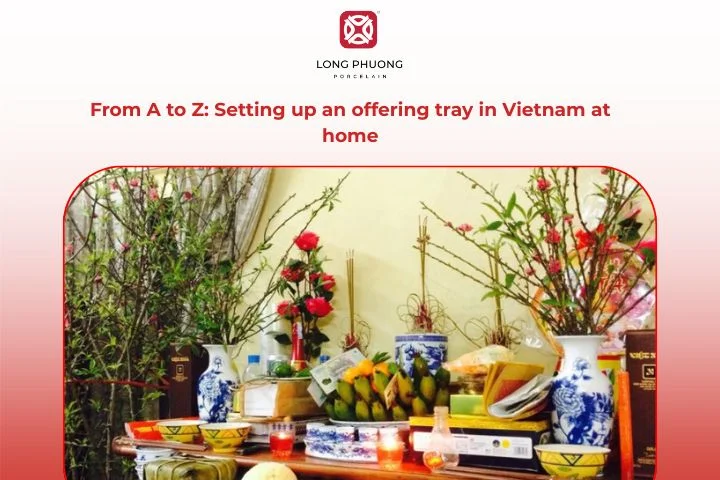
1. What is an offering tray in Vietnam?
In Vietnam, an offering tray is more than a collection of food and drinks, it represents respect and gratitude toward ancestors. The offering tray in Vietnam is arranged on family altars during death anniversaries, festivals, or special days to honor loved ones and invite them to join the meal symbolically.

It symbolizes respect, gratitude, and the filial piety (hiếu thảo) central to Vietnamese values. The dishes are carefully chosen and prepared, reflecting the finest and best the family has to offer, thus symbolizing prosperity and well-wishes for the future.
In short, the offering tray in Vietnam acts as a bridge, connecting the living with the departed, ensuring their continued well-being and blessing for the family.
2. The meaning behind the offering tray in Vietnam
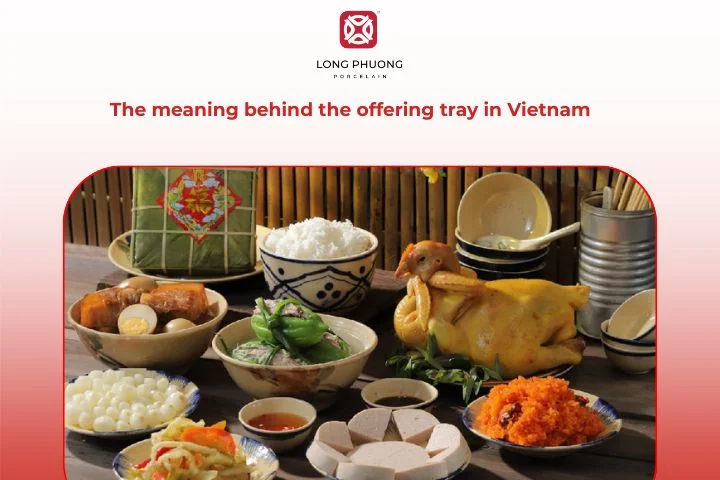
The offering tray in Vietnam reflects the country’s spiritual connection between the living and the deceased. Preparing the tray is a way of expressing thankfulness for blessings and wishing for peace and prosperity in the household.
The offerings serve several vital purposes:
- Gratitude and Filial Piety: It is the primary way for descendants to show deep thanks and respect to their ancestors for their sacrifices and contributions.
- A Shared Feast: The belief is that ancestors return to partake in the offerings. The act of placing the food on the altar is the first step of this shared feast between two realms.
- Seeking Blessings: By showing respect, the family asks the ancestors to bless them with health, good fortune, and prosperity.
- Unity and Community: Preparing the offering tray in Vietnam often involves all family members, strengthening the bonds between generations and within the immediate family.
Every dish, every arrangement, and every utensil on the offering tray is infused with meaning, often adhering to the principles of Yin-Yang and the Five Elements (Metal, Wood, Water, Fire, Earth) to achieve perfect harmony.
3. Revealing complete offering tray for the 3 regions in Vietnam
Vietnam’s three main regions: North, Central, and South, each carry their own customs when it comes to preparing an offering tray. Let’s explore the regional differences that make this tradition so unique.
3.1. Offering tray in Northern Vietnam
The offering tray in Northern Vietnam is known for its formality and balance. The arrangement focuses on harmony between colors, flavors, and presentation.
A typical tray includes:
- Boiled chicken with lemon leaves
- Sticky rice or steamed rice
- Vietnamese ham
- Stir-fried dishes
- Soup, often bamboo shoot soup or vegetable broth
- Fresh fruits and betel leaves
Northern families take great care in arranging the tray symmetrically, showing their deep sense of ritual and order.
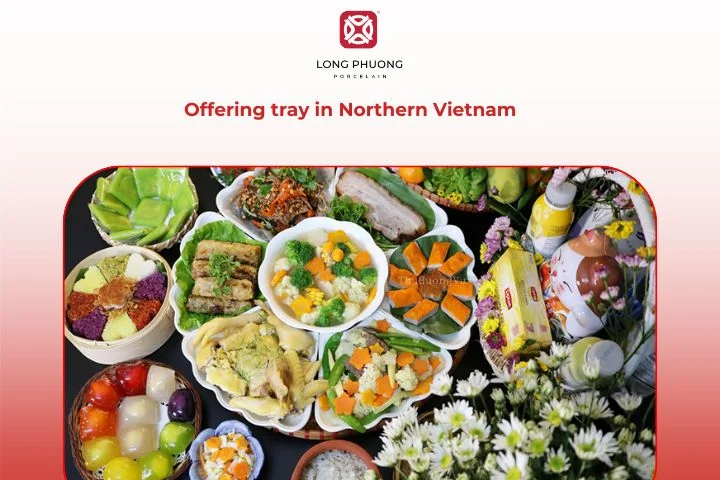
3.2. Offering tray in Central Vietnam
Central Vietnam, home to the ancient royal capital Hue, often displays offering trays that are both colorful and refined. Influenced by royal cuisine, these trays feature a wide range of dishes that highlight craftsmanship and visual appeal.
Common items include:
- Steamed pork rolls
- Fried spring rolls
- Grilled fish
- Pickled vegetables
- Hue-style cakes (banh beo, banh nam, banh loc)
- Sweet soups (che)
Central people believe that the beauty of the tray reflects the family’s respect and devotion.
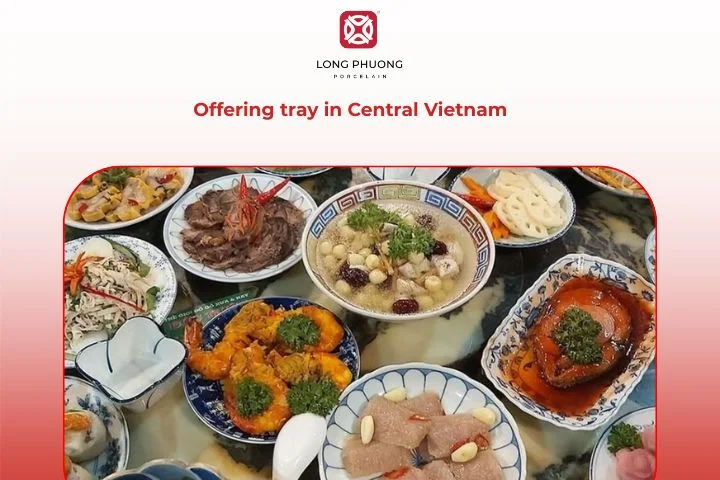
3.3. Offering tray in Southern Vietnam
The offering tray in Southern Vietnam embraces warmth and generosity. It often includes a variety of sweet and savory dishes that symbolize abundance and good fortune.
Common foods include:
- Stewed pork and eggs in coconut juice
- Braised fish
- Sour soup (canh chua)
- Sticky rice
- Fresh fruits such as coconut, banana, and mango
Southern people tend to arrange their trays freely, focusing more on heartfelt sincerity than strict symmetry.
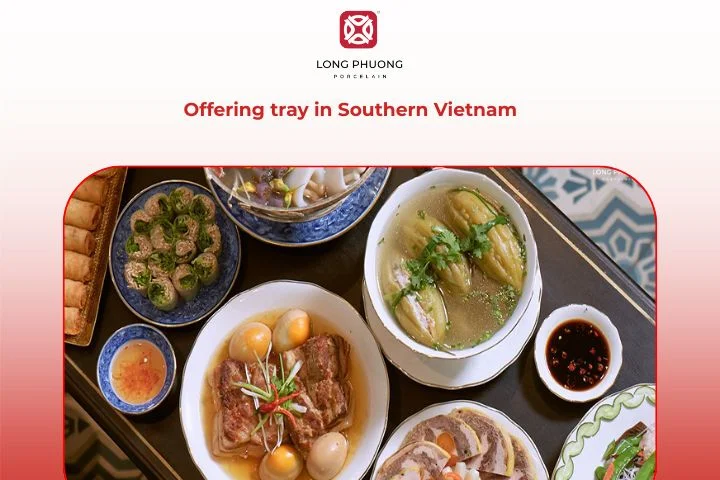
4. How to prepare a complete offering tray at home
Preparing the offering tray is an act of love and devotion. It requires careful planning and execution.
Here are the steps and common dishes used for family death anniversaries, a common time for preparing a complete offering tray in Vietnam.
Essential Components (The 6 Main Dish Categories):
- Boiled Dish: A whole boiled chicken or a plate of boiled pork belly.
- Fried/Stir-fried Dish: Spring rolls or a stir-fry with vegetables and meat.
- Soup: A large bowl of soup, varying by region (e.g., bamboo shoot soup in the North, bitter melon soup in the Central/South).
- Steamed Dish/Sausage: Slices of Vietnamese ham or savory steamed cakes.
- Rice/Sticky Rice: A bowl of steamed white rice or a plate of colorful sticky rice.
- Dessert/Fruit: A plate of seasonal fruits or a sweet soup.
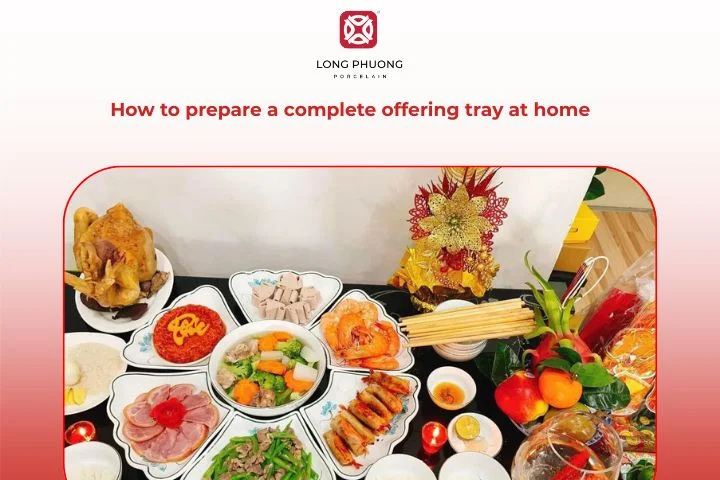
The Preparation Process:
- Plan Ahead: Decide on the menu days in advance, keeping in mind regional traditions and the favorite foods of the deceased.
- The Altar: The altar must be clean. Incense, fresh flowers, a pair of candles, and fresh water are placed first.
- The Tray: The dishes are arranged artfully on a large, beautiful platter or tray.
- Placing the Offerings: The tray is carefully carried and placed on a lower table or directly on the altar, depending on the space and family custom. The dishes are positioned to face the ancestor tablet or photo.
- The Ritual: Incense is lit, and the family patriarch or matriarch recites a prayer, inviting the ancestors to enjoy the feast and asking for their protection.
- The Shared Feast: After the incense burns down (usually about 1/3 of the stick), the ancestors are considered to have finished. The food is then taken down, and the entire family gathers to share the meal, making it a true communion.
5. Important notes when preparing the offering tray in Vietnam
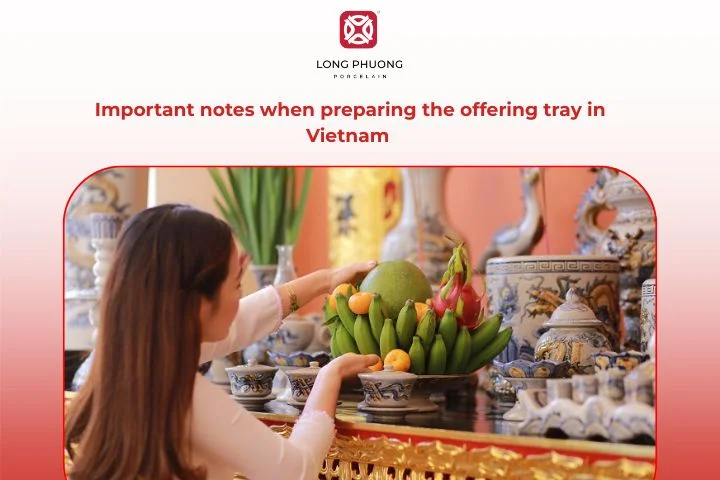
To ensure the ritual is performed respectfully and successfully, a few important guidelines must be followed.
5.1. For the ritual offering tray
- Odd Numbers for Rituals: In general, for specific offerings (like incense sticks, flowers, or fruit plates), Vietnamese tradition often favors odd numbers (1, 3, 5, 7) which symbolize growth and the Yang principle.
- Freshness is Key: All ingredients must be the freshest and highest quality available.
- Cleanliness: Utmost hygiene and cleanliness are required for both the cooking process and the utensils.
- No Tasting: Traditionally, the cook should not taste the food during the cooking process. The food is cooked exclusively for the ancestors first.
- Proper Attire: When performing the ritual, family members should wear respectful, modest clothing.
5.2. For the family feast after offering
After prayers, the meal becomes a family gathering where everyone enjoys the food together. It’s a time for connection and gratitude – a reminder of the family bond that continues beyond generations.
6. Suggested porcelain sets for a beautiful offering tray
A complete offering tray in Vietnam not only depends on food but also on elegant porcelain tableware. High-quality porcelain enhances the beauty and meaning of each ritual. Here are some recommended sets from Long Phuong Porcelain:
6.1. Twisted leaf tableware sets
The elegant, subtle leaf pattern adds a natural, organic feel, symbolizing life and renewal. This set works perfectly for a traditional, yet refined, offering tray.
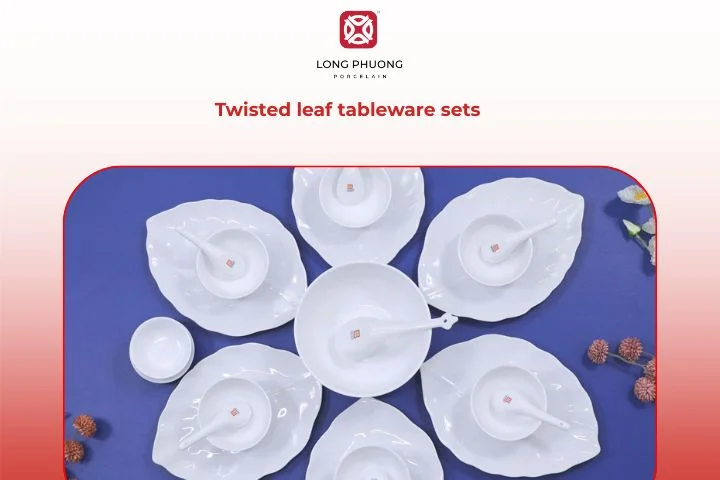
6.2. An Nhien tableware sets
“An Nhien” translates to peaceful and relaxed. This simple, pristine white porcelain set focuses attention purely on the vibrant colors and careful arrangement of the food, embodying purity and reverence.
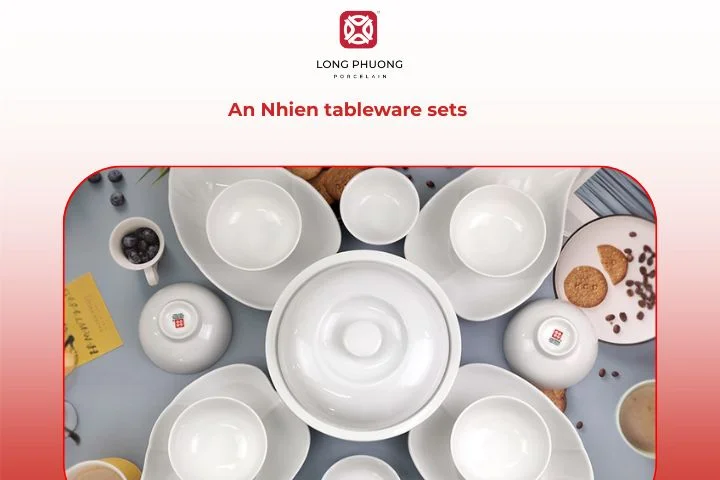
6.3. An Khuong tableware sets
Inspired by Vietnamese culture, the An Khuong set combines classic shapes with modern details, creating a balanced and refined look for your offering tray.
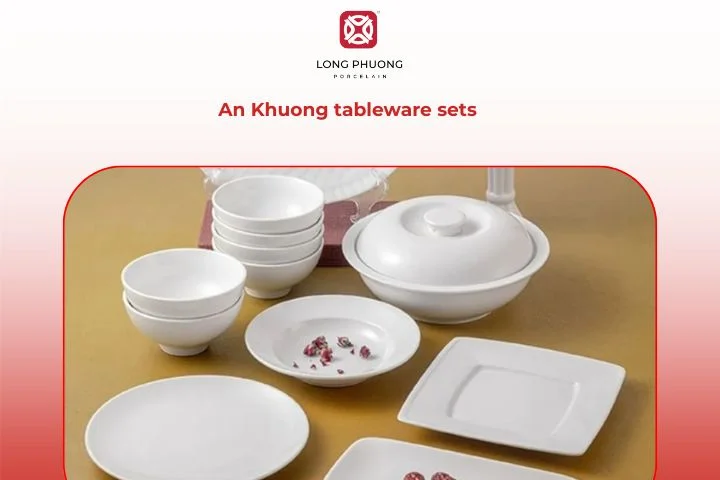
6.4. Cuu Long tableware sets
Inspired by the mighty Mekong River, Cuu Long sets often feature a classic, sturdy design. They offer a sense of grandeur and historical depth, making them ideal for the most important family occasions.
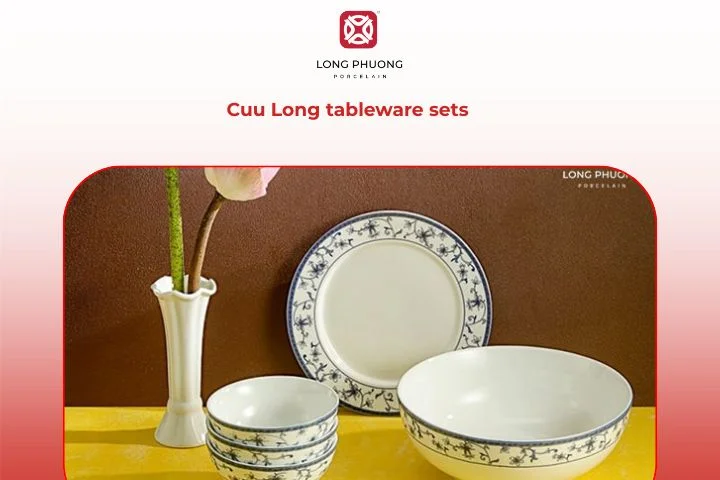
6.5. Kim Lai gold plated tableware sets
For the most sacred and important occasions like Tết or major Ngày Giỗ, the Kim Lai (Golden Coming) sets, with delicate gold trim, offer unparalleled luxury and respect. Gold is a symbol of fortune and excellence, the perfect complement to the most meticulous offering tray in Vietnam.
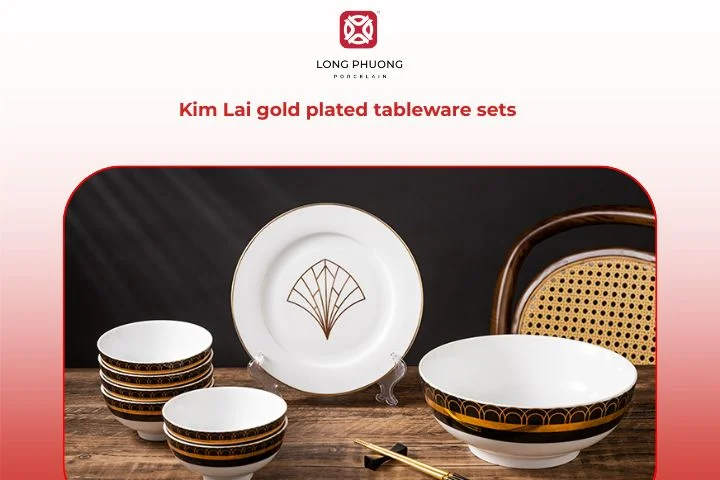
7. Where to buy high-quality porcelain sets for your offering tray
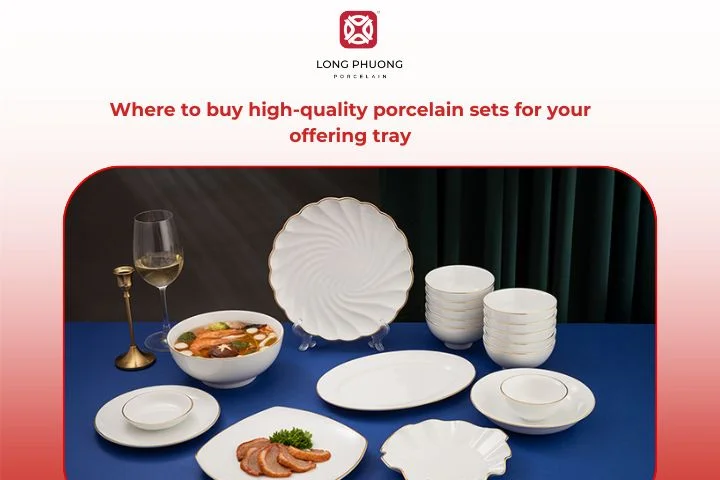
When choosing porcelain for your offering tray in Vietnam, quality matters. The dishes must withstand heat, maintain color, and complement the solemnity of the altar.
Long Phuong Porcelain is one of Vietnam’s trusted porcelain brands, known for:
- Premium craftsmanship and durability
- Elegant designs suitable for both daily use and rituals
- A wide range of collections, from classic to luxury styles
If you’re looking to create a meaningful and beautiful offering tray, explore Long Phuong’s tableware sets today. Each piece is crafted to bring grace and harmony to your family gatherings.
👉 Visit Long Phuong Porcelain to find the perfect porcelain sets for your home and traditions.
8. FAQs

8.1. How to set up a Vietnamese altar?
A typical Vietnamese altar includes:
– A family altar cabinet.
– Ancestor tablets or photos of the deceased.
– An Incense burner.
– A set of five-fruit trays – essential for Tết and often present on the offering tray.
– A pair of candles or oil lamps.
– Vases for fresh flowers.
– Small cups for water, tea, or liquor.
The altar should always be placed in a clean, high, and respectful place, often the central room of the house.
8.2. Can I prepare a simple offering tray at home?
Yes, a simple offering tray in Vietnam can include rice, boiled chicken, fruits, and tea. Sincerity is more important than quantity.
8.3. When do Vietnamese people usually prepare an offering tray?
The offering tray in Vietnam is prepared for all major events:
– Lunar New Year and subsequent Tet holidays.
– Death Anniversaries of family members.
– Mid-Year Festival, 5th day of the 5th lunar month.
– Mid-Autumn Festival.
– The first and fifteenth day of the lunar month.
8.4. How do you show gratitude in Vietnamese culture?
Vietnamese people express gratitude through rituals, family meals, and the respectful preparation of an offering tray in Vietnam – a tradition that connects past and present generations.
Related Articles
CEO of Long Phuong Group Joint Stock Company, with more than 20 years of exploration and research to obtain the best formulas and professional experience, Long Phuong Porcelain has produced more than 400 designs of all kinds of household porcelain, Significant contributions to Vietnam's ceramic industry.
 Vietnam
Vietnam
